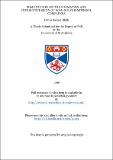Files in this item
Some studies on the formation and interconversion of iron-sulfur nitrosyl complexes
Item metadata
| dc.contributor.advisor | Glidewell, Christopher | |
| dc.contributor.author | Blyth, Debra F. | |
| dc.coverage.spatial | 170 p. | en_US |
| dc.date.accessioned | 2018-07-10T14:20:33Z | |
| dc.date.available | 2018-07-10T14:20:33Z | |
| dc.date.issued | 1996 | |
| dc.identifier.uri | https://hdl.handle.net/10023/15193 | |
| dc.description.abstract | Studies on the effect of substituting iron(III) for iron(II) or nitrate for nitrite in the reaction of cysteine with iron(II) salts and nitrite with and without sodium ascorbate present demonstrated the formation of the tetranuclear Na[Fe₄S₃(NO)₇] complex when iron(III) is substituted for iron(II), albeit in smaller yield; but no iron-sulfur-nitrosyl clusters were detected when nitrite was replaced with nitrate. Similarly in the case of reaction of methionine with iron(II) salts and nitrite in the presence of sodium ascorbate, the dinuclear complex Fe₂(SMe)₂(NO)₄ is formed in reduced yield when iron(III) is substituted for iron(II) and no iron-sulfur-nitrosyl complexes are detected when nitrite is replaced with nitrate. The effect of pH on the reactions of cysteine and methionine with iron(II) salts and nitrate, with and without sodium ascorbate present in the case of cysteine, were studied. The cysteine reactions showed that in the presence of sodium ascorbate, the yield of Na[Fe₄S₃(NO)₇] fell slightly as pH was decreased due to formation of the less soluble ascorbic acid from acidification of sodium ascorbate. At very low pH both cysteine reactions with and without sodium ascorbate present did not yield Na[Fe₄S₃(NO)₇] due to the formation of nitric oxide from nitrite, which would rapidly oxidise to give nitrogen dioxide, and to the instability of the Na[Fe₄S₃(NO)₇] complex itself at very low pH. The dinuclear complex Fe₂(SMe)₂(NO)₄ is very stable to conditions of low pH but its formation at very acidic conditions was hindered, again due to the formation of nitric oxide from nitrite. A range of iron-sulfur containing amino acid complexes of the general type [Fe₃o(amino acid)₆(H₂0)₃]X₇, were synthesised and their reactions with nitrite studied. In the presence of sodium ascorbate, when the amino acid is methylcysteine, both [Fe₄S₃(NO)₇]' and Fe₂(SMe)₂(NO)₄ were isolated after reaction with nitrite. However no identified iron-sulfur-nitrosyl complexes could be detected when the amino acid was methionine. In the absence of sodium ascorbate both the methylcysteine and methionine complexes yielded a range of unidentified complexes which infra-red spectroscopy demonstrated absorbed strongly in the nitrosyl stretching region and it was postulated that the species observed were inorganic nitrosyl complexes. FTIR analysis of Fe₄S₄(NO)₄ in the polar coordinating solvents THF, DMF and DMSO demonstrated conversion to [Fe₄S₃(NO)₇]⁻. No such conversion was observed using the solvents diethyl ether or dichloromethane. An intermediate species was observed in THF and DMSO using FTIR spectroscopy which was postulated to be a [Fe(solvent)₆][Fe₄S₄(NO)₄]₂ complex. Another peak observed in the latter stages of the conversion was believed to be that of a dinuclear Fe(SR)₂(NO)₄ type complex. ESR analysis of Fe₄S₄(NO)₄ in THF and DMSO however demonstrated formation of a mononuclear species of type [Fe(NO)₂(X)₂]ⁿ⁺. Thus in the dilute solutions required for ESR analysis, mononuclear species of the type [Fe₂(NO)₂(X)₂]ⁿ⁺ are favoured but in the more concentrated solutions needed for FTIR analysis polynuclear species of the type [Fe₄S₄(NO)₄] are predominant. | en_US |
| dc.language.iso | en | en_US |
| dc.publisher | University of St Andrews | |
| dc.subject.lcc | QD341.N8B6 | |
| dc.subject.lcsh | Iron compounds | en |
| dc.title | Some studies on the formation and interconversion of iron-sulfur nitrosyl complexes | en_US |
| dc.type | Thesis | en_US |
| dc.type.qualificationlevel | Doctoral | en_US |
| dc.type.qualificationname | PhD Doctor of Philosophy | en_US |
| dc.publisher.institution | The University of St Andrews | en_US |
This item appears in the following Collection(s)
Items in the St Andrews Research Repository are protected by copyright, with all rights reserved, unless otherwise indicated.

